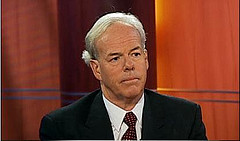Biography: Terry Shaunessy is President and Founder of Shaunessy Investment Counsel, a Calgary based money manager, specializing in quantitatively derived domestic and international investment portfolios for institutions, corporations and ultra high net worth families. Prior to founding his own firm, Terry gained extensive capital markets experience in his roles as President of Gordon Capital, Director of Equity Research, Merrill Lynch Canada, Executive Vice President, Institutions HSBC Asset Management (Canada) and Managing Partner and Portfolio Manager, Gryphon Investment Counsel.
Q: Let’s start off by getting to know your macro outlook of the markets.
A: The short version is that there is a global economic recovery underway. There is no double dip, the recovery is unstoppable. It will be slightly different in as much as the United States will not be the engine for this recovery. The engine of growth will be in Asia, India and Latin America and that is something that will persist for the balance of this century. Under those circumstances, we tend to ignore most of the hand wringing that’s occurring around traditional ways of looking at market cycles. So while we are not looking for the U.S. economy to do particularly well, (expect it to expand at a two and a half(ish) kind of growth rate), we never confuse what’s happening with the economy with what’s happening with the capital markets.
Given these conditions, our asset of choice is equities. We do think that earnings will drive equity markets. Export oriented equities will do the best. We know that with regards the S&P 500, 50% of sales right now come from outside the U.S. That will only get bigger over time. Earnings will continue to surprise on the upside, due to a combination of better than expected earnings from the banks, as their loan loss provisions keep dropping given that they are such a big component of the S&P earnings. This is something most strategists have got wrong. The other reason for better than expected earnings is that generally analysts in the U.S. are underestimating the earnings power of export oriented big cap S&P 100-type companies that dominate that index. So we really like the S&P 500. By virtue of the fact that about two thirds of the TSX Composite is either in energy or materials, this index is obviously going to do well. The banking system here in Canada is just fine and we’re not concerned about that. The U.S. market will probably do a bit better than the Canadian market and the only thing that we really are a bit cautious on is the fixed income market.
Q: Given this outlook, what is your current asset allocation strategy as it pertains to your benchmark portfolio?
A: We are at maximum equity exposure right now for our portfolio. We run a multiple asset portfolio, which is broken down into roughly 65% equities, 10% in alternative assets, which we classify as real estate and commodities and about 25% in fixed income. So essentially 65% for the kind of money that we run would be a maximum equity exposure.
Q: Let’s dig a little bit deeper into those different allocations, starting with the fixed income part. Now you mentioned that you were slightly cautious with regards to the fixed income markets, so what is your current thesis and what assumptions are you making for the next quarter? Also, how have you positioned the fixed income portfolio to take advantage of your thesis??
A: Our fixed income allocation is based on basically two views: One is that interest rate risk is bigger now than credit risk. As a result of the fiasco that happened in the fourth quarter of 2008 most investors have been too focused on credit risk and interest rate risk we think is enormous. To give you some idea, the ten-year either Government of Canada or U.S. Treasury bond typically trades around 5% or 5.5 % which is basically where we think they’re going back to. As you know in the current market most of these bonds are trading at 3% or less, so there is enormous vulnerability over the next couple of years for what will happen to the ten-year bond.
The second thing is that with quantitative easing inflation in the future is inevitable. Inflation is a monetary phenomenon and the only way that North American governments are going to be able to deal with these debt levels is to basically debase the value of the debt over time. So what you don’t want to be is in long-term government bonds.
Q: What exactly composes that 25% fixed income allocation in your benchmark portfolio?
A: At the moment about 60% is invested in the bond index, XBB is the ETF if you’re an ETF player. The duration’s roughly about 6.5 years and we’re comfortable with that. What we don’t want to do is telescope the interest rate outlook and we will start to take duration down in the first quarter of 2011. We also own high-yield bonds, corporates and we like real return bonds.
Q: With regards to the alternative part of your benchmark portfolio hat includes real estate and commodities, were you referring to equities that have exposure to real estate and commodities or the actual hard stuff?
A: As we are equity managers, we are using the capital markets for our exposure to these asset classes. So for real estate exposure in Canada, we are using the iShares S&P TSX Capped REIT Index ETF (XRE:TSX). We’ve also just started to make a small allocation to U.S. real estate and recently begun adding the iShares Dow Jones US Real Estate ETF (IYR:NYSE) as we’re not concerned about the state or outlook of the commercial real estate in the U.S. at all. The Dow Jones US Real Estate ETF, (IYR:NYSE) provides great exposure to the industrial, multi-residential and office sectors of the real estate market.
Our alternative asset allocation is broken down into roughly 5% in real estate, and 5% in direct commodity ETFs. Our commodity exposure is split 50% between gold ETFs and a broad commodity index ETF.
Q: To touch a little bit on gold which has had an amazing run over the last 5 years in US dollar terms - what are your thoughts on gold going forward??
A: We look at gold as a currency because it is convertible into any currency you can think of. With the U.S. basically jeopardizing the stability of their own currency in the long run by virtue of how they’re dealing with their debt problems using the Federal Reserve, we just prefer to be in gold. It’s really a process of elimination as the U.S. government is essentially not holding the line, the Euro was a joke and we don’t have any more faith in the French and Germans than we do in the Americans. The Japan Yen is finished as a currency. So what ends up happening is that if you’ve got to hold something, then what we’re seeing with central banks (mostly in China) is that they’re continuing to hold gold. Furthermore, institutional investors are saying that you need to have at least 5-10% of your portfolio invested in a commodity-based asset.
Q: Are there any other commodity groups that you like other than gold?
A: We like the agricultural commodity group more than anything else. There are multiple ways that investors can gain exposure to this group but we have elected to use a broader fairly recent ETF that Claymore came out with, which is about 1/3rd agriculture, 1/3rd energy and 1/3rd precious and base metals. I also like the agricultural commodities themselves, not the agriculturally exposed equities, like a Potash or a Deere but the commodities themselves and the PowerShares DB Agriculture Fund (DBA:NYSE) provides exposure to commodities like corn, wheat and soybeans and that’s where we want to be.
Q: With the Canadian Dollar almost at par with the US Dollar, what are your thoughts on hedging one’s currency exposure? How do you go about hedging currency risk?
A: We have elected to be hedged at all times and in our smaller portfolios we use the currency hedged ETFs that are available either from iShares or from Claymore to accomplish this. For our larger accounts where we can actually run a hedge, we’re running a 90-day hedge where we basically sell U.S. dollars forward for 90 days and roll them on the calendar quarter and we’re still 100% hedged there. Once the dollar gets through par, the hedging aspect is not as important. So at 1.01 or 1.02 (CAD to USD), which is where I think where we’ll see the exchange rate in the first quarter of 2011 is where we’ll probably start to take the hedges down a bit.
Q: You’ve already touched on this but can you go a little deeper with regards to your thoughts on the real estate sector and REITs in particular?
A: In Canada it’s pretty straightforward. Canadian real estate is generally artificially held up by institutional investors. People should be aware that pensions plans like the Ontario Teachers Pension Plan, the Canada Pension Plan, the BC Investment Management Corporation, Alberta Investment Management Corp,. and the Caisse de dépôt have such large portfolios that in keeping with diversification a fair bit of money has a tendency to flow back into the Canadian real estate markets. So generally al lot of real estate tends to be directly owned as opposed to leveraged. Then you have some good operators like RioCan (REI.UN:TSX), which is the single largest stock in the iShares S&P TSX Capped REIT Index ETF (XRE:TSX), which also happens to be a fabulous company. So you may choose to either buy XRE or just buy RioCan directly – as in our opinion they’re interchangeable.
The U.S. has had a crisis in residential real estate. It was thought that it would extend to commercial real estate but we don’t think that’s a likely outcome because the U.S. already had a crisis in commercial real estate in the early 1990’s and since a lot of portfolio managers weren’t around 20 years ago, they were not aware of that. You generally don’t get two crises within one generation so commercial real estate in the United States is undervalued.
Q: As the BRIC countries continue to drive the global economy, what are your thoughts on global equities on a valuation basis? What instruments do you use to add global equity exposure to your portfolios?
A: We’ve kept it pretty simple. In terms of emerging markets, we play in the big markets and the big stocks. Claymore’s come out with a Canadian dollar hedged emerging markets ETF that tracks the MSCI Emerging Markets Index and is invested in the Vanguard Emerging Markets ETF under the ticker CWO:TSX. and we’re probably invested 10% or 15 % in that particular name. On the non-emerging international parts, when you start to look at the EAFE Index or particular regions, we have a small exposure to EAFE, which is unusual since it’s such a big index but what we’ve chosen to do is to invest a little heavier in the iShares MSCI Germany Index Fund (EWG:NYSE) and the reason we did that is because German stocks, like Canadian stocks are dominated by export-oriented companies.
Q: Mr. Shaunessy, you’ve been quoted as not being a fan of active ETFs but in a recent interview we conducted with Howard Atkinson of Horizons ETFs, Mr. Atkinson mentioned that Active ETFs “will be the fastest growing ETF category over the next 10 years.” Given your frequent use of ETFs, what are your thoughts on active ETFs?
A: I don’t agree with that at all. An active ETF brings together the worst of both worlds. Typically active managers underperform markets. With active ETFs what ends up happening is that there is a move away from one of the reasons people like ETFs and that is that the Management Expense Ratios (MER) on them are very cheap. , Even though the MERs on active ETFs are a lot less than those of mutual funds, the fact that they’re more expensive than regular ETFs combined with the fact that most active managers underperform the markets, makes us not agree with Howard’s statement.
Q: Are there any specific stocks that you own?
A: We will buy specific stocks if there is a very good story around them. So the one that we’ve bought the most of has been Citigroup (C:NYSE) in the United States. We’re looking at that thing to be at least a double or triple in the cycle, which we don’t think is available in Canada. The other thing is that we’d be a buyer of General Motors (GM:NYSE).
GM is a global story. The Americans are so parochial in terms of how they see the world that what they don’t understand is that GM was the icon for U.S. manufacturing. In the late 20th century the company went downhill along with U.S. manufacturing and then it kind of unceremoniously went bankrupt. That provided the opportunity to restructure the company and get away from the craziness they had with the unions, whilst cutting down their product lines and basically allowing them to expand their sales outside the United States. GM is the number 1 selling vehicle in Brazil, Russia, India, China. So, do I care if Americans don’t like GM cars? I could not care less. All I care about is that young Chinese people, for one reason or another, love Buicks. Don’t ask me why but as long as they like them, I’m all for that.
Thank You, Mr. Shaunessy!










